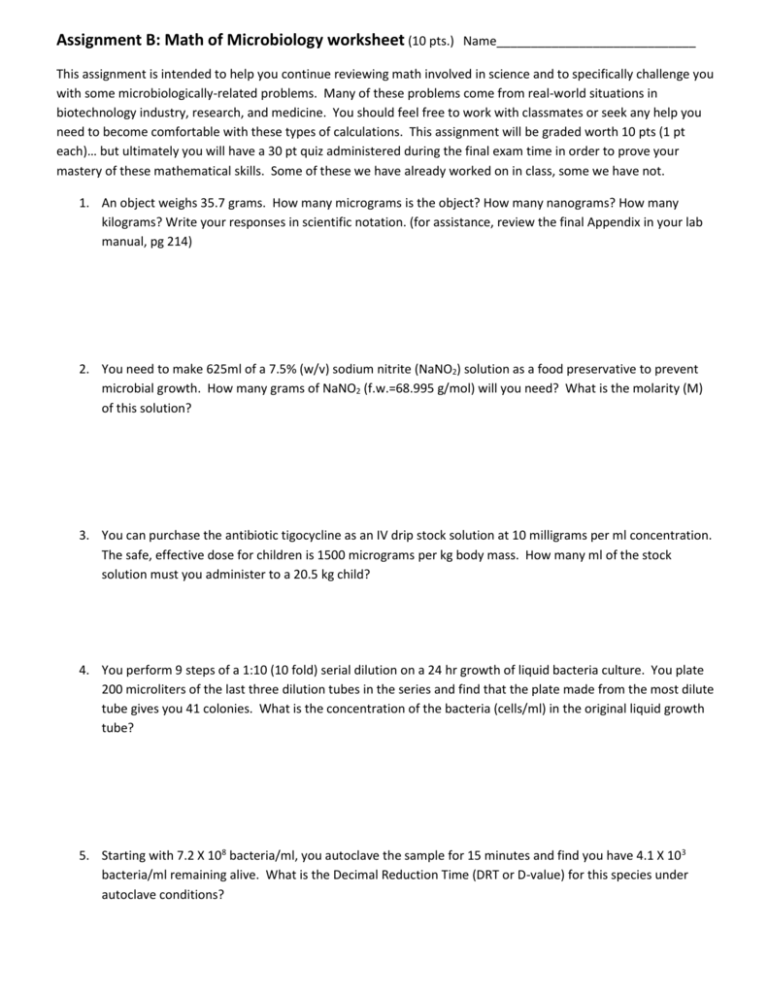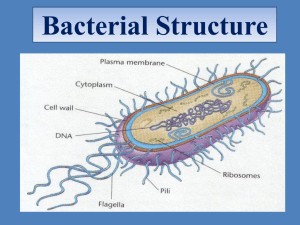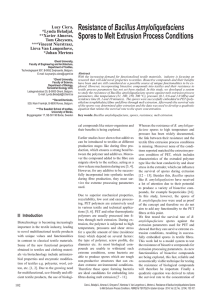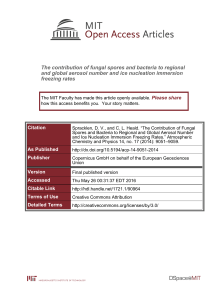Math of Microbiology worksheet - Academic Resources at Missouri
advertisement

Assignment B: Math of Microbiology worksheet (10 pts.) Name_____________________________ This assignment is intended to help you continue reviewing math involved in science and to specifically challenge you with some microbiologically-related problems. Many of these problems come from real-world situations in biotechnology industry, research, and medicine. You should feel free to work with classmates or seek any help you need to become comfortable with these types of calculations. This assignment will be graded worth 10 pts (1 pt each)… but ultimately you will have a 30 pt quiz administered during the final exam time in order to prove your mastery of these mathematical skills. Some of these we have already worked on in class, some we have not. 1. An object weighs 35.7 grams. How many micrograms is the object? How many nanograms? How many kilograms? Write your responses in scientific notation. (for assistance, review the final Appendix in your lab manual, pg 214) 2. You need to make 625ml of a 7.5% (w/v) sodium nitrite (NaNO2) solution as a food preservative to prevent microbial growth. How many grams of NaNO2 (f.w.=68.995 g/mol) will you need? What is the molarity (M) of this solution? 3. You can purchase the antibiotic tigocycline as an IV drip stock solution at 10 milligrams per ml concentration. The safe, effective dose for children is 1500 micrograms per kg body mass. How many ml of the stock solution must you administer to a 20.5 kg child? 4. You perform 9 steps of a 1:10 (10 fold) serial dilution on a 24 hr growth of liquid bacteria culture. You plate 200 microliters of the last three dilution tubes in the series and find that the plate made from the most dilute tube gives you 41 colonies. What is the concentration of the bacteria (cells/ml) in the original liquid growth tube? 5. Starting with 7.2 X 108 bacteria/ml, you autoclave the sample for 15 minutes and find you have 4.1 X 103 bacteria/ml remaining alive. What is the Decimal Reduction Time (DRT or D-value) for this species under autoclave conditions? 6. You grow a liquid culture initially containing 50,000 bacteria, which have an average doubling time of 64 minutes, in log growth phase for 21 hours. How many cells do you have? 7. You have 3.3 X 109 bacteria on a surface measuring 25cm X 50cm. You disinfect with a chemical and destroy 99.95% of the cells. If the sanitization requirement reads “an average of no more than 1 X 103 cfu per square cm”, have you achieved sufficient decontamination? 8. You weigh out 2g of soil, suspend it in 500 ml buffer in a bottle, shake the bottle to release the bacteria from the soil particles, and perform serial dilutions and platings on a Bacillus-selective media. You find that a 100 microliter plated sample from the 10-6 dilution tube gives you 123 Bacillus colonies. How many average Bacillus are in each gram of soil? 9. You have produced a 3,000 liter tank of fungal spores at a density of 2.7 X 107 spores/ml. You must package these spores in bags containing 2.5 liters volume at a final concentration of 8 X 105 spores/ml. How much volume of your spore suspension and how much water must be added to each packaging bag? How many containers will you be able to produce? 10. Soybean seeds coated with 1 X 105 Bacillus amyloliquefaciens bacteria germinate more rapidly and grow taller than uncoated seeds. There are 950 soybean seeds per kg. If B. amyloliquefaciens is supplied at a concentration of 1.3 X 108 cfu/ml, how much volume of bacterial suspension must be used to appropriately coat 7,300 kg of seeds needed for planting a field?







